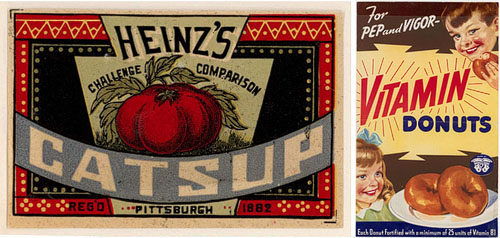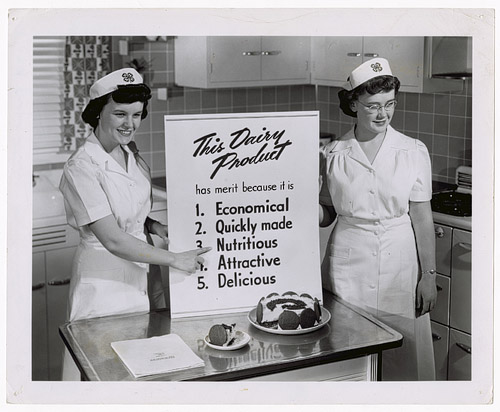‘What’s Cooking Uncle Sam‘ is the newest exhibition on view at the National Archives in Washington DC. It is a show that traces the government’s role in both food production and consumption of the Unites States. The exhibition features a collection of office stationery ranging from posters and pamphlets to product labels and photographs of the various meals enjoyed by Presidents. I asked the curator, Alice Kamps, a few questions regarding the National Archives collection and the exhibition which will be on view until the 3rd of January.

Right: Vitamin Doughnuts Poster (1942), National Archives, Records of the Agricultural Marketing Service
Interview with Alice Kamps, exhibition curator
What do you collect today of the American food culture for the exhibitions and collections of tomorrow?
The National Archives keeps the documents and materials created in the course of business conducted by the United States Federal government that are judged to be important for legal or historical reasons. These materials are preserved because they are important to the workings of Government, have long-term research worth, or provide information of value to citizens. The records created in the course of Government initiatives, legislation, and programs that relate to food are among these records.
There are a number of advertisements for food and products in the exhibition, do you collect and document the digital advertising on the internet and through email?
The food advertisements and labels in the exhibition were submitted to the Government in the course of various government activities. The National Archives keeps digital and other advertising records from government files that are judged to be of historical value.

What about food blogs? Are you archiving any websites in their entirety in order to preserve them for future generations?
The National Archives archives blogs and other electronic records created in the course of government business.
How did you approach curating this exhibition? Are there any predominate themes running throughout the collection?
After surveying food records from a variety of different government agencies, I decided to narrow the scope by focusing on those that tell interesting stories about how Government affects our food supply and food choices. These included things like agricultural activities, nutrition education programs, food safety regulation, school lunch, and military food service. Many of the themes in the exhibit echo today’s concerns about food: the safety of additives, the diversity of plants, and the nutritional quality of the foods we eat.

Looking at the food and nutrition of yesterday, have you learned any important information that is relevant today?
It was fascinating to learn about the evolution of our understanding of nutrition and the ways it has shaped the foods we eat. As science revealed new insights about the nutritional value of different foods, our approach to food became more scientific. There was a movement away from eating foods simply for pleasure or cultural tradition to eating foods that are “good for us.” With the benefit of hindsight, we can see where particular ideas about nutrition were overblown or simply inaccurate. We might consider this before we make drastic changes in our diet based on the latest scientific discoveries.
What is your favorite work in the exhibition?
I have many “favorites” but here’s one of them (below). It’s a photograph of a nutrition demonstration done in the course of a 4-H program. I love the fact that the women are wearing what look like nurse’s uniforms and are presenting what appears to be a cake made from whipped cream and some kind of cookies. It isn’t exactly what we would call nutritious today, not that we wouldn’t still enjoy eating it. But it meets their standards: it’s economical, quickly made, nutritious, attractive, and delicious. These were attributes that were highly valued by home economists. They believed that it was wasteful and inefficient to spend a lot of time and money on cooking.

‘What’s Cooking, Uncle Sam? The Government’s Effect on The American Diet’ is on view starting 10 June 2011 until 3 January 2012 in The Lawrence F. O’Brien Gallery of the National Archives in Washington D.C.

10 comments
Megan Fizell (@tresjoliestudio) (@tresjoliestudio) says:
Jun 13, 2011
Exhibition Interview – ‘What’s Cooking Uncle Sam’ at The National Archives http://goo.gl/fb/eIFy4 #food #art
Big Fan says:
Jun 14, 2011
I like the colors in the labels and posters. The Uncle Sam Garden poster is “deja vu” with the resurgence of home and community gardens to offset food costs.
Julie says:
Jun 14, 2011
I, too, love colorful food posters and label. I find it fascinating how a good marketing campaign can alter what we we crave. And the 4-H picture above is hilarious! Nilla Wafers and whipped cream are nutritious?
Rosa says:
Jun 15, 2011
Very interesting! Thanks for sharing. I love the retro posters.
Cheers,
Rosa
siri says:
Jun 15, 2011
What a bizarre/completely facinating exhibition- now if only I could get to NYC before January somehow. That last photo is FAB.
deana says:
Jun 15, 2011
The Nixon meal sends chills… those food service girls… well times they have changed!
Simon Food Favourites says:
Jun 16, 2011
that photo of “This dairy product has merit” is priceless. love it! how advertising has changed :-)
sally says:
Jun 24, 2011
Looks like a great exhibit! I’ll have to go see it the next time I am in DC.
my spatula says:
Jun 28, 2011
What a fabulous exhibit! I wouldn’t leave once I got there.
Keely aka The Richest Girl in Bondi says:
Jun 29, 2011
Sounds like an absolutely fabulous exhibit! It’s so interesting to see the ‘Garden to cut food costs’ poster, as veggie gardens are gaining popularity again now. I also wonder how they decide which items ‘make the cut’.